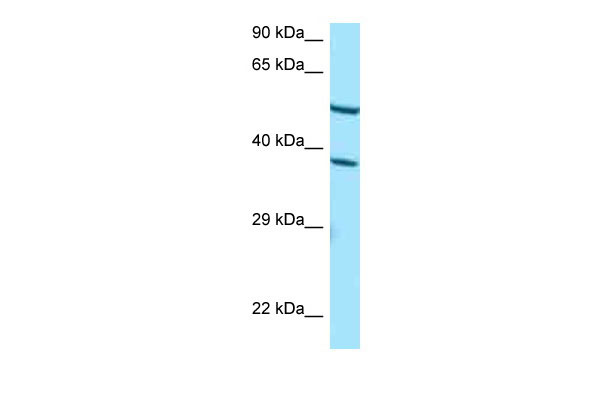CYP4F2 antibody - C-terminal region
Rabbit Polyclonal Antibody
- 产品详情
- 实验流程
Application
| WB |
|---|---|
| Primary Accession | P78329 |
| Other Accession | NM_001082, NP_001073 |
| Reactivity | Human, Mouse, Rat, Rabbit, Goat, Dog, Guinea Pig, Horse, Bovine, Sheep |
| Predicted | Human, Pig, Bovine, Sheep |
| Host | Rabbit |
| Clonality | Polyclonal |
| Calculated MW | 59853 Da |
| Gene ID | 8529 |
|---|---|
| Alias Symbol | CPF2 |
| Other Names | Phylloquinone omega-hydroxylase CYP4F2, 1.14.13.194, 20-hydroxyeicosatetraenoic acid synthase, 20-HETE synthase, 1.14.13.-, Arachidonic acid omega-hydroxylase, CYPIVF2, Cytochrome P450 4F2, Cytochrome P450-LTB-omega, Leukotriene-B(4) 20-monooxygenase 1, Leukotriene-B(4) omega-hydroxylase 1, 1.14.13.30, CYP4F2 (HGNC:2645) |
| Format | Liquid. Purified antibody supplied in 1x PBS buffer with 0.09% (w/v) sodium azide and 2% sucrose. |
| Reconstitution & Storage | Add 50 ul of distilled water. Final anti-CYP4F2 antibody concentration is 1 mg/ml in PBS buffer with 2% sucrose. For longer periods of storage, store at 20°C. Avoid repeat freeze-thaw cycles. |
| Precautions | CYP4F2 antibody - C-terminal region is for research use only and not for use in diagnostic or therapeutic procedures. |
| Name | CYP4F2 {ECO:0000303|PubMed:10492403, ECO:0000312|HGNC:HGNC:2645} |
|---|---|
| Function | A cytochrome P450 monooxygenase involved in the metabolism of various endogenous substrates, including fatty acids, eicosanoids and vitamins (PubMed:10660572, PubMed:10833273, PubMed:11997390, PubMed:17341693, PubMed:18574070, PubMed:18577768). Mechanistically, uses molecular oxygen inserting one oxygen atom into a substrate, and reducing the second into a water molecule, with two electrons provided by NADPH via cytochrome P450 reductase (CPR; NADPH-ferrihemoprotein reductase). Catalyzes predominantly the oxidation of the terminal carbon (omega-oxidation) of long- and very long-chain fatty acids. Displays high omega-hydroxylase activity toward polyunsaturated fatty acids (PUFAs) (PubMed:18577768). Participates in the conversion of arachidonic acid to omega-hydroxyeicosatetraenoic acid (20-HETE), a signaling molecule acting both as vasoconstrictive and natriuretic with overall effect on arterial blood pressure (PubMed:10660572, PubMed:17341693, PubMed:18574070). Plays a role in the oxidative inactivation of eicosanoids, including both pro-inflammatory and anti- inflammatory mediators such as leukotriene B4 (LTB4), lipoxin A4 (LXA4), and several HETEs (PubMed:10660572, PubMed:10833273, PubMed:17341693, PubMed:18574070, PubMed:18577768, PubMed:8026587, PubMed:9799565). Catalyzes omega-hydroxylation of 3-hydroxy fatty acids (PubMed:18065749). Converts monoepoxides of linoleic acid leukotoxin and isoleukotoxin to omega-hydroxylated metabolites (PubMed:15145985). Contributes to the degradation of very long-chain fatty acids (VLCFAs) by catalyzing successive omega-oxidations and chain shortening (PubMed:16547005, PubMed:18182499). Plays an important role in vitamin metabolism by chain shortening. Catalyzes omega-hydroxylation of the phytyl chain of tocopherols (forms of vitamin E), with preference for gamma-tocopherols over alpha-tocopherols, thus promoting retention of alpha-tocopherols in tissues (PubMed:11997390). Omega-hydroxylates and inactivates phylloquinone (vitamin K1), and menaquinone-4 (MK-4, a form of vitamin K2), both acting as cofactors in blood coagulation (PubMed:19297519, PubMed:24138531). |
| Cellular Location | Microsome membrane; Peripheral membrane protein. Endoplasmic reticulum membrane; Peripheral membrane protein |
| Tissue Location | Liver. Also present in kidney: specifically expressed in the S2 and S3 segments of proximal tubules in cortex and outer medulla (PubMed:10660572). |
Research Areas
For Research Use Only. Not For Use In Diagnostic Procedures.
Application Protocols
Provided below are standard protocols that you may find useful for product applications.
REFERENCES
Kikuta Y.,et al.FEBS Lett. 348:70-74(1994).
Kikuta Y.,et al.DNA Cell Biol. 18:723-730(1999).
Chen L.,et al.Submitted (JUL-2000) to the EMBL/GenBank/DDBJ databases.
Ota T.,et al.Nat. Genet. 36:40-45(2004).
Grimwood J.,et al.Nature 428:529-535(2004).
终于等到您。ABCEPTA(百远生物)抗体产品。
点击下方“我要评价 ”按钮提交您的反馈信息,您的反馈和评价是我们最宝贵的财富之一,
我们将在1-3个工作日内处理您的反馈信息。
如有疑问,联系:0512-88856768 tech-china@abcepta.com.























 癌症的基本特征包括细胞增殖、血管生成、迁移、凋亡逃避机制和细胞永生等。找到癌症发生过程中这些通路的关键标记物和对应的抗体用于检测至关重要。
癌症的基本特征包括细胞增殖、血管生成、迁移、凋亡逃避机制和细胞永生等。找到癌症发生过程中这些通路的关键标记物和对应的抗体用于检测至关重要。 为您推荐一个泛素化位点预测神器——泛素化分析工具,可以为您的蛋白的泛素化位点作出预测和评分。
为您推荐一个泛素化位点预测神器——泛素化分析工具,可以为您的蛋白的泛素化位点作出预测和评分。 细胞自噬受体图形绘图工具为你的蛋白的细胞受体结合位点作出预测和评分,识别结合到自噬通路中的蛋白是非常重要的,便于让我们理解自噬在正常生理、病理过程中的作用,如发育、细胞分化、神经退化性疾病、压力条件下、感染和癌症。
细胞自噬受体图形绘图工具为你的蛋白的细胞受体结合位点作出预测和评分,识别结合到自噬通路中的蛋白是非常重要的,便于让我们理解自噬在正常生理、病理过程中的作用,如发育、细胞分化、神经退化性疾病、压力条件下、感染和癌症。






